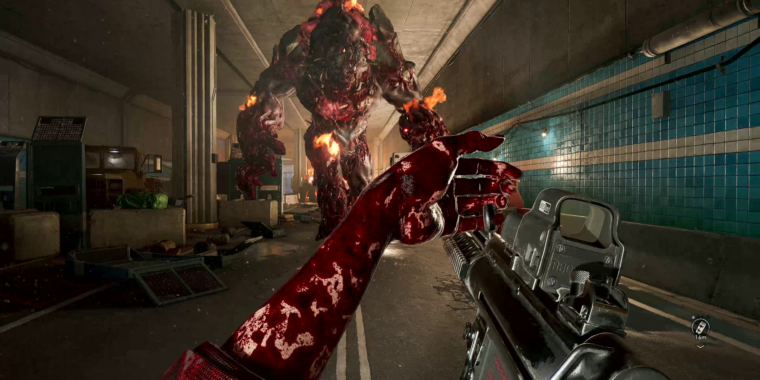Back 4 Blood alpha test: Building decks, killing zombies, having co-op fun
[ad_1]

Turtle Rock Studios
The face of co-op gaming was changed forever by Valve’s Left 4 Dead in 2008 at a time when playing games with online friends usually meant killing each other or killing other teams of real players. Left 4 Dead had a different idea: take the fun of a solidly scripted single-player battle against AI zombies, then make it crazier with squadmates and randomness.
In every mission, your team of four had to traverse a linear, apocalyptic series of levels, pre-constructed with paths and cinematic events but remixed for each playthrough with new enemy and item configurations. Your crew could memorize some of the challenges, but an AI system would always watch for slip-ups—then pounce with dangerous, AI-controlled enemies for your foursome to contend with.
Entire co-op subgenres have emerged in the 12 years since L4D‘s launch, but few have aped its exact structure (with the obvious exception of 2009’s Left 4 Dead 2). Hence, the most obvious selling point for this week’s gameplay reveal of co-op shooter Back 4 Blood, slated to launch June 2021, is simple: the L4D formula is back, and it’s coming from a team that co-created the original. But is that good enough?
Based on my tests with the game’s closed alpha version, which went live Thursday morning and will operate for invitees until Monday, December 21, my answer is a cautious-yet-optimistic “yes.”
Slaughter 4 nostalgia
-
Let’s just lop that pesky little head right off, shall we?
-
The game will eventually include eight “cleaner” characters, who are somehow immune from zombie infection and get their own mild stat boosts or unique weapons.
-
Dynamic lighting has changed a lot since the days of Left 4 Dead 2 Here’s the before shot…
-
…and here’s the after.
-
Big gun for a big crowd.
-
Guns are crucial, and they don’t necessarily appear in stores, so you have to luck out and pick them up during levels.
-
Some bonuses can be purchased mid-mission, though 1,000 copper in this game’s economy is quite a bit.
-
This super zombie’s big, slammin’ hand doesn’t just hurt; it can also shove—and in some cases, those shoves can lead you to an immediate death, which isn’t recommended.
-
Molotov cocktails, grenades, and improvised explosives are all highly recommended.
-
Methinks the game’s blood modeling on your squadmates could use a touch-up before the closed alpha ends.
-
Hop from train car to train car, lest you lose the upper tactical advantage.
Many of B4B‘s concepts are lifted shamelessly from L4D (if the naming convention with a number “4” didn’t clue you in). To wit: each of the game’s “campaign” zones is broken up into smaller levels, and your squad gets an opportunity to rest, heal, and stock up on supplies at a “safe zone” between each level. Use guns, melee weapons, and explosive implements to tear through zombies, and juggle health items and tools to get your team from one safe zone to the next.
So far, only one such zone is available in the closed alpha, and a competent squad can expect to beat its four levels in around 80 minutes. It’s all classic L4D stuff: Eerie, foggy woods; abandoned warehouses; woods and towns with abandoned cars and homes, which offer a mix of multi-lane paths but eventually converge—and are patrolled by admittedly familiar zombies (here, called “ridden,” but let’s be real: they’re zombies).
Like in L4D, average shambling-right-at-you zombies are easy to kill in isolation but can overwhelm in waves, and these are broken up by L4D-like “super” zombies. The Retch, for example, combines the acid-spitting properties of L4D‘s Spitter and the hazardous-goo-splosion issues of L4D‘s Boomer. And the Snitch shambles through open fields of zombies but will react like a L4D Witch and scream to attract a horde if a squad doesn’t team up and kill it quickly. In other words, many L4D ideas have been carried over and remixed in a don’t-fix-what-isn’t-broken way.
Cards 4 combat
The game’s biggest meaningful difference from its L4D inspirations comes from a new card system—which, yes, normally sets off our alarms. Cards? Is this some system of little digital trinkets that have to be purchased with real-world money?
So far, it looks like that may not pass—though Turtle Rock Studios has been careful not to detail exactly what kind of microtransaction system might emerge. In good news, at least, creative director Chris Ashton insists that concepts like “pre-order DLC,” which wracked their previous game Evolve, won’t be designed to split the player community with differing gameplay options.
“We’re super sensitive to that,” Ashton says. “We had such a bad run of it with Evolve, that, like, in every meeting we’ve been in, we’re insanely adamant about the way stuff is going to work [in the game].”
-
This gallery includes a selection of cards that players can build decks out of in the closed alpha. Remember, the cards are shuffled and dealt in random ways, so even if you build a “dream” deck, whether you get the perfect cards or not is still up to random chance.
-
“Pre-alpha art” as an indicator of the work Turtle Rock has ahead.
-
If you could see yourself consistently pausing and sniping, the “hunker down” card may be perfect for your playstyle.
-
“Deal with the Devil” is a pretty incredible trade-off, as the game’s brutal difficulty in the closed alpha period makes “lives” (aka, full-squad continues) quite valuable.
-
“Martyr” does a lot for you and your teammates, but whoever puts it in their deck is sacrificing the option of getting more personally useful perks.
-
The game’s AI “director” draws unique cards at the outset of every level, as well, and these stack additional dangers onto your journey ahead. At least the game is decent enough to announce them so clearly.
With that out of the way, think of Slay the Spire, a game where players amass a deck of game-altering cards over the course of standard gameplay. You’ll unlock cards through the course of B4B‘s campaign, and each offers perks that either provide mild mechanical boosts (use less stamina while sprinting) or interesting gameplay tweaks (when you switch between your primary and secondary weapon, the “stowed” one instantly reloads).
Randomness 4 longevity
I mention Slay the Spire because you don’t simply slap cards onto your character and get perks. Instead, you’ll build a limited deck—currently, 15 cards—and take it into a campaign level. One card can be a guaranteed draw, but the rest appear randomly whenever your squad reaches a safe zone, as if you’re drafting your apocalyptic traits. Whenever you’re about to get a new card, you draw three, pick one, and shuffle the rest back into your deck.
B4B‘s alpha includes dozens of cards, and you can narrow those down to build decks that favor different play styles. Some perks favor melee attacks; others offer ranged weapon boosts (damage, reload speed); and still others make your character better at healing squadmates, discovering items, or boosting in-game cash (spent at safe zones or saved between campaign missions). Ultimately, however, the cards you draw will be random; in the same way that your squadmates’ tactics and scrounged weapons and items vary, the favorite cards you pick will be random, as well.
That mix of randomness and emergent gameplay fits pretty tidily with the L4D formula, and as such, the card system is already one of my favorite B4B tweaks. The game’s AI “director” also has its own deck of cards that inform players of specific dangers to expect in a given level. Sometimes they’re as simple as clarifying which “super” zombies you might see more of, but other times they offer wild twists, like pumping up fog to decrease visibility or turning the lights out altogether in a level and forcing players to navigate with flashlights. The closed alpha is playing these director cards close to the vest, it seems, but I’m looking forward to seeing how wild those challenge cards end up being in the final game.
Systems 4 substance
Back 4 Blood closed alpha gameplay; while the footage here is very similar to what I played on PC, the dialogue is a lot smoother in this official video. The game still needs a serious pass on voiced dialogue, as not much is in the game just yet.
The game includes a few other system-level tweaks that are welcome. There’s the aforementioned in-game currency, dubbed copper, that players can rack up to purchase useful items and weapon upgrades at safe zones—and that leaves you with a potential deck-building tradeoff. Should you skip copper-earning boosts in favor of other perks and traits, you might find yourself woefully short on accumulating much-needed med kits and bandages—or unable to buy “tool kits,” a new item that lets you open doors without setting off alarms, or pick locks on resource-loaded stock rooms.
Beyond that, my initial impressions of the weapon spread are quite good. Shotguns have a delightful, head-splattering kick; booming machine guns do a great job mowing down crowds, so long as you mind the wicked recoil; wimpier machine guns offer better aim should you want to direct their fire more carefully at super zombies; and melee weapons do serious damage when your strikes are correctly timed (and, with the right cards, can be “charged” to whack a larger crowd at once). You’ll want to curate a particular deck before emphasizing certain weapons, although that can paint players into a tricky corner should the ideal weapon never emerge (even though some cards guarantee certain weapon pickups).
None of that matters if the levels don’t leave room for satisfying combat encounters, and the four on display thus far do just that. B4B‘s alpha campaign zone isn’t as memorable as, say, the rock concert of L4D1 or the boathouse of L4D2, but it does end with a pretty wild bombing run, where players must carry explosives into an abandoned ferry, set them up at its lowest level, then run out and blow the whole thing up—while one player hangs back and mans a massive turret used to shoot at zombies through the ferry’s windows to protect squadmates (though, gosh, be careful with the friendly fire). On the way there, a few setpiece moments, particularly a multi-part battle against a 24-foot-tall Goliath, flex some sumptuous, next-gen muscle beyond the L4D series’ Source Engine roots.
Obviously, we’re still left wondering what shape the final game will take, or whether microtranscations or other balance issues will creep up before its retail launch on June 22. But in a wacky, cooped-up year like 2020, the harrowing, cooperation-filled combat of Back 4 Blood, and its attention to systems suited for repeat gameplay, already feels like the kind of game I want to master with my friends as soon as possible.
[ad_2]
Source link




